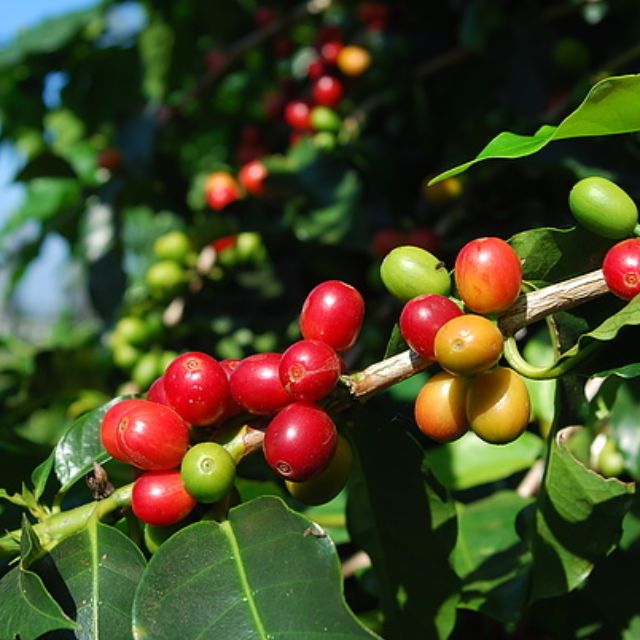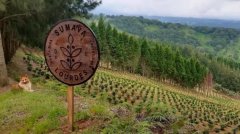Do you know what rosy summer and bourbon look like? Teach you to identify six common varieties of coffee!

Professional coffee knowledge exchange more coffee bean information please follow the coffee workshop (Wechat official account cafe_style)
Do you know what rosy summer and bourbon look like? There are many varieties of coffee, and each variety has different appearance features, but it is not so easy to distinguish. Regardless of the differences in flavor characteristics, each variety actually has some differences in appearance.
Some coffee trees are taller, others are as small as bushes, and coffee fruits may vary greatly in size and color. In this article, let's take a look at the appearance differences of six common varieties in Arabica.
How to identify different varieties of coffee?
There are hundreds of varieties of coffee, but about 70% of the varieties grown in the world belong to Arabica. Although Arabica is less resistant to disease than Roberta, its flavor and aroma are better. Some of the more common varieties in Arabica circulate in boutique coffee and futures-rated markets.
Producers choose to plant a variety for many reasons, including yield, flavor characteristics, local environmental and climatic conditions, and so on. Identifying coffee varieties can avoid mixing with other coffee in the process of harvest and processing. Mixing two or more batches of coffee may lead to confusion of flavor characteristics and low cup scores.
In order to better understand the physical differences of the most common varieties, the authors studied six different types of Arabica coffee. About two months after the harvest and the beginning of flowering, the farms were sampled in Pokuit, Panama, at elevations between 1300 and 1800 meters above sea level.
The appearance features written in this paper can analyze and identify specific plants, but this paper is used as a personal observation and is not intended to be studied as an overall reference.
We use some physical properties to identify plants, including:
Height (tall or small)
The color of the leaf tip (green or bronze)
The shape of a plant (cone or circle)
The shape of a leaf (slender or wide)
Shape and size of fruits and raw beans (slender, round; small, medium, large or very large)
The color of the fruit (red, yellow, orange or pink)
The angle of branch growth
The spacing of branches (short or long)
Spacing of nodes in the same branch (short or long)
Not all of the above features will be used to identify varieties, because some varieties themselves have obvious biological characteristics.
1. Tibica Typica
Tibica has obvious appearance features and is probably the easiest variety to identify. The plant is conical and the main trunk can be up to 5 meters long. The height of the tree means that the distance between the branches and the nodes on the same branch is longer than that of other varieties.
The lateral branches form an angle of 50 to 80 degrees from the trunk. The trunk and branches are not very stout. Leaves, fruits and raw beans are usually slender, and the tips of the leaves of this species of trees are bronze when they are young.
Compared with other Arabica varieties, Tiebika leaves have a smoother surface, less serrated edges and bright red fruit ripening.
two。 Bourbon Bourbon
Bourbon has the same tall tree body and cone shape as Tibica, but its branches grow thicker and have more secondary branches. The trunk of this variety is larger and the branches look thicker, so the tree is stronger than iron and less soft. The distance between branches and nodes is also a little short, and this increase in density means that bourbon produces about 30% more fruit than other coffee varieties.
The leaves are wider than iron cards and have a bump texture with wavy edges. The young leaves are usually green, but sometimes the tips are bronze. The fruit is round and ripe in red, orange or yellow (but does not change on the same plant).
3. Kaddura Caturra
Many Arabica varieties are descended from Bourbon and Tibica. Kaddura is a natural dwarf mutant of bourbon with shorter trees and denser branches. The distance between its branches on the trunk and many secondary branches is small, making Kaddura's branches thicker than Tibica or bourbon.
It has similar features to bourbon, with wavy borders and green tips. The fruit is also round, normal size and red or yellow when ripe.
Ripe red Kaddura fruit
4. Kaduai Catuai
Kaduai is a combination of Mondonovo and Kaddura. It is mentioned earlier that Kaddura is a natural variety of bourbon and Mondonowood is a natural variety of Tibica. In Kaduai you can find some of the biological features of Tibica and bourbon.
The tree of Kaduai is short, and the side branches are closely angled with the main branches. Seen from the top of the plant, there are few secondary branches, which makes Kadu Abby's conical iron more umbrella-shaped than card and bourbon.
Kaduai leaves are wavy, usually with green tips, but occasionally you can see some Kaduai with bronze tips. The fruit of this variety will not easily fall from the branches and has a strong ability to resist wind and rain. The variety is a high-yielding variety that produces round, normal-sized fruit, usually ripe red or yellow, and occasionally orange Kaddura.
5. Pacamara Pacamara
The Pacamara is a combination of Pacas and elephant beans and was successfully mated by the Salvadoran Coffee Research Institute in 1958. This variety is not a stable variety, which means that plants propagated in the same generation will have genetic inconsistencies, but it is still widely cultivated.
Pacas is another variety of bourbon, while elephant bean is a variety of Tibika. The elephant bean itself has unusually large fruit, and this characteristic is passed on to the Pacamara variety. The size of the fruit and special pointed leaves make the Pacamara highly recognizable, which can be green or bronze.
The tree is small and the plant is conical in shape. The distance between the nodes between the branches is very short, which makes it a dense plant. Trunks and branches are similar to bourbon because they are stronger and less soft than most other varieties.
6. Rose summer Geisha/Gesha
This very popular variety is easily identified by the angle of the upper branch and the shape of the plant. The branches facing the top extend to the sky at an angle of 45 to 50 degrees. The tree in Rose Summer is tall, the distance between branches and nodes is very long, and the trunk and branches are very thin, a bit like Tibica.
The leaves are smooth and slender, and the fruit is similar to Tibica. According to the author, the main obvious difference between Rosa and Tibica is that the former both have an umbrella or flat roof, while Tibica is conical.
The ripe Rosa fruit tastes completely different from other varieties, with citrus flavor, sweetness and jasmine aroma.
Dried rose summer beans
Extended Reading: four things you should know about Rosa Coffee
Different varieties of coffee are not only different in flavor and appearance, but also different plants visually. Arabica raw beans being planted or processed can be more easily identified by studying the shape and shape of trees, as well as the characteristics of fruits and leaves.
In this paper, Sawang Tongdee. Written and translated from Perfect Daily Grind.
Translated by Chengzhen Coffee, reproduced, please tell me the source.
END
Important Notice :
前街咖啡 FrontStreet Coffee has moved to new addredd:
FrontStreet Coffee Address: 315,Donghua East Road,GuangZhou
Tel:020 38364473
- Prev

Comparison of the flavor of hand-made coffee between Shumawa Black Honey and Jushi Manor in Costa Rica
Professional coffee knowledge exchange more coffee bean information Please follow the coffee workshop (Wechat official account cafe_style) recently bought a new Stonehenge Manor Black Honey processed coffee beans, so there is little difference between this Stonehenge Manor Black Honey and Shumawa Manor Black Honey? Today, the editor will compare ~ | Manor introduction Shumawa Manor [Shumawa Manor] is located in the west.
- Next

What is the processing method of Brazilian coffee, the largest coffee producer in the world?
Professional coffee knowledge exchange more coffee bean information please follow the coffee workshop (Wechat official account cafe_style) Brazil is the world's largest coffee producing country accounts for about 30% of coffee production, but because Brazil is located in rainy forest areas, the land is flat with few high-altitude mountain forests, most of the coffee species are planted in low-altitude non-volcanic soil areas, and there is not too much shelter.
Related
- Does Rose Summer choose Blue, Green or Red? Detailed explanation of Rose Summer Coffee plots and Classification in Panamanian Jade Manor
- What is the difference between the origin, producing area, processing plant, cooperative and manor of coffee beans?
- How fine does the espresso powder fit? how to grind the espresso?
- Sca coffee roasting degree color card coffee roasting degree 8 roasting color values what do you mean?
- The practice of lattes: how to make lattes at home
- Introduction to Indonesian Fine Coffee beans-- Java Coffee producing area of Indonesian Arabica Coffee
- How much will the flavor of light and medium roasted rose summer be expressed? What baking level is rose summer suitable for?
- Introduction to the characteristics of washing, sun-drying or wet-planing coffee commonly used in Mantenin, Indonesia
- Price characteristics of Arabica Coffee Bean Starbucks introduction to Manning Coffee Bean Taste producing area Variety Manor
- What is the authentic Yega flavor? What are the flavor characteristics of the really excellent Yejasuffi coffee beans?

